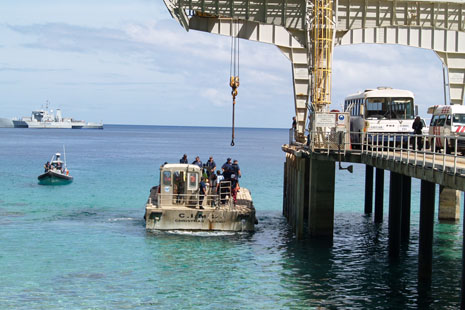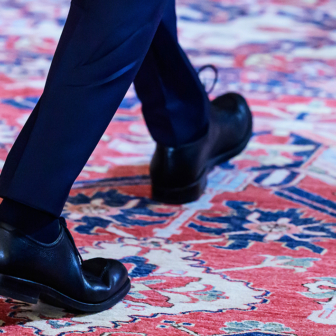THE AIRPORT on Christmas Island is a social place. Local residents hang out at the airport to meet and chat or watch who is arriving or leaving on one of the three flights each week. They sit around drinking beers and ordering toasted sandwiches from the airport kiosk while waiting passengers make the most of the island’s GST exemption by purchasing cheap alcohol and cigarettes to take back to mainland Australia.
But as I drove up the island’s steep hill towards the airport on 17 January I expected to encounter a different Christmas Island airport scene. Outside the terminal, twenty-eight people, mainly from Afghanistan, mingled with a handful of locals. Others sat inside shuffling visa documents while waiting for their flight. As I entered the airport, I heard a familiar, “Sa’lam Miss Michelle, chetoor hasti?” – “hello, how are you?” “Khob astom,” I responded – “I am good” in the little Dari I had learnt from the Afghan asylum seekers living in community detention on the island. I was unsure how to ask whether “everyone was extremely happy and excited” in Dari, but it was obvious from the smiling faces that the answer would be bah-le, or “yes.” The group of people I had come to farewell had been the first boatpeople to arrive under a Rudd government and were the first to receive permanent protection visas.
The scene at the airport gives some indication of how Australia’s asylum seeker policy has changed since Labor came to power. During the Howard years, Christmas Islanders usually didn’t have an opportunity to say goodbye to refugees. When the Hao-Kiet Vietnamese refugees left for the mainland in 2006, for example, a bus drove them directly onto the tarmac. Like criminals, they were then whisked straight onto the plane. One local resident, who spent a great deal of time with the boatpeople who arrived last year, told me she farewelled the asylum seekers the day before they left simply because “I did not think I was allowed to go to the airport to say goodbye.”
Another key difference is the much quicker processing of asylum seekers, as the detention and processing timeframes for the boat arrivals on 30 September and 7 October 2008 show very clearly. On 20 November, five out of the six unaccompanied minors from both boats moved into community detention under the care of a welfare agency, Families South Australia. On 3 December, the families and the other unaccompanied minor moved into community detention. On the 19 December, the men from the two boats moved into community detention in Silver City neighbourhood. Red Cross, which is the contracted care group on Christmas Island, assisted the families and adults. On Christmas Eve, DIAC informed everyone from boats one and two that they could apply for protection visas in early January 2009. And on 17 January – less than four months after their arrival – everyone from these two groups resettled in Adelaide after receiving permanent protection visas. Thirty-six boatpeople who arrived in 2008 have received permanent protection visas and resettled in Adelaide.
The government’s move towards community detention on Christmas Island needs careful reconsideration, however. Currently there are three families from Iraq and Afghanistan and twenty unaccompanied minors, the majority from Afghanistan, living in community detention. Christmas Island is an intriguing place, closer to Indonesia – Java is only 300km to the north – than mainland Australia. Its quirks include the famous red crab migration, a mountainous jungle landscape that looks like something from Jurassic Park, and constant conversations about ridiculous food prices (nine dollars will buy you half a red cabbage). Fascinating Christmas Island may be, but it is not a great place for community detention.
One problem is transport. Facilities on the island are dispersed and the island is quite hilly. Red Cross makes available transport to essential places such as the doctor and the supermarket, but otherwise community detainees – men, women and children – must hitch rides with locals or walk in the sweltering tropical heat. The island does have a community bus but it only travels a few times a day: someone catching the bus from Drumsite neighbourhood (where the families are detained) to go to the pharmacy or post office in Settlement must leave at 9.30am and wait until 12.30pm for another bus.
Boredom is another problem. When I spent time with the families from both of the 2008 boats they would constantly tell me about the boredom they were experiencing. There are no local volunteer or community organisations to organise activities for the asylum seekers. They do not receive enough money to pay for recreational activities. Hopefully, this issue will be resolved with Red Cross’ decision to send a recreational officer to the island in January.
Detention problems on Christmas Island are not confined to community arrangements. In response to the increase in the number of boat arrivals the new $400 million maximum-security detention centre became operational in December. Christmas Island is already over 2000 km from mainland Australia, but the centre itself is situated at North West Point, a remote location even by island standards. It takes twenty minutes to drive from the island centre along dodgy roads that are mostly unbituminised and contain potholes. It can be a dangerous drive during the wet season. Until last weekend, no one from the local community had made a social visit to the boat people detained there, partly because of the centre’s location and partly because people are unsure whether social visits are allowed. It is unlikely the detainees will receive visits from mainlanders when flights to the island cost around $2000. The only people detainees interact with are the fly-in, fly-out processing and detention staff who arrive on the weekly charter flight, which – according to testimony before a parliamentary committee this week – costs $70,000 every time it operates.
According to Hakim, who was one of the first asylum seekers to experience living at North West Point, told me that the new centre feels like a prison. The only difference between North West Point and jail was that “we were not handcuffed.” He found the constant camera surveillance and electronically controlled doors intimidating: it felt “like I was in a cage.” Hakim, who recently resettled on the mainland, also told me that he was depressed for most of the time he spent in the centre. Hakim is confused as to why asylum seekers are treated this way. “We come here to be safe, we are not criminals,” he said. He feels that people would become clinically depressed, if locked up at North West Point for too long.
As I was saying goodbye at the airport I suggested to several refugees that their recent experiences were like the chapters of a book. The terrible chapters in Afghanistan had passed, the Christmas Island chapter was approaching its last few pages, and their new life in Adelaide was the happy ending. Perhaps this analogy extends to Australia’s asylum seeker policy. The dark chapter during the Howard years is closed. The Christmas Island chapter is still open, and shows no sign of closing following the department’s decision to use the facility to detain Australia’s newest asylum seekers, fifty-four boatpeople intercepted last week. It will not be until Labor stops community detention on Christmas Island, closes the maximum-security detention centre and moves people to the mainland for processing, that Australia’s asylum seeker policy can humanely enter its next chapter. •




